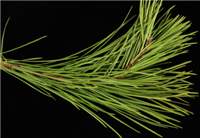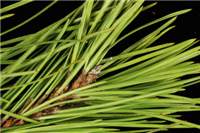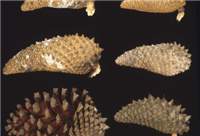Name
Pinus attenuata Lemmon, Gard. & Forest 64: 45 (1892).[Knobcone pine]
Description
Habit: A small tree 6-25 m high, occasionally taller, variable but frequently with a spreading, gaunt open habit particularly when open grown; trunk typically crooked and forked at least once; branches ascending and sinuous, with closely pressed, persistent, elongated, backward-pointing cones. Older trees develop a straggly, rounded crown of sparse foliage.
Bark: In young trees thin, smooth or flaking, pinkish grey to pale brown. In old trees thick, scaly and ridged at the base of the trunk, remaining smooth on upper trunk and branches, dark brown and often tinged purple.
Foliage: Needles in groups of three or occasionally two, usually 12-16 cm (occasionally 7-20 cm) long, 1-2 mm wide; grey-green; erect and stiff, may be twisted or kinked near base; spreading widely on main shoots, forward-pointing close to the shoot on minor shoots. Leaf sheath brown, persistent; initially 1-2.5 cm long, becoming shorter.
Branchlets: Green at first, becoming light greenish brown, darker in the second year; without hairs, ridged; young branchlets crowded.
Winter buds: Oval-oblong to cylindrical, drawn out to a tapering point; dark brown, often thickly coated with white resin; scales closely appressed, but often some free scale tips at base.
Cones: Solitary or in clusters, often with two or three clusters on a single year’s growth, pointing back along the stem; remaining on the tree unopened for many years (serotinous) and becoming grey and covered with algae; at first short stalked but with the stalk (and sometimes the actual cones) gradually becoming enclosed in the thickening branches or stem. Shape usually narrowly conical, curved, often asymmetrical at the base, 8-16 cm long, 4.5-6 cm wide when closed; light shiny yellow-brown, becoming grey-brown. Scales on the outer side of the cone elongated (hence the specific name ‘attenuata’), nearly flat on the inner side and near the apex on the outer side of the cone; armed with sharp scales at first. Scale tip and prickle pointing towards the apex of the cone.
Seeds: Small, ca. 5 mm long, black, grooved, ovoid to ellipsoidal; wing 1.8-2.0 cm long.
Notes
Pinus attenuata is most likely to be confused with Pinus radiata. The serotinous habit of the cones is more pronounced in P. attenuata than in any other species and the narrow long-conic cones with swollen outer cone scales, while quite variable, are unlike those of any other serotinous species. Among the other three-needled pines, the greenish brown young shoots and grey-green needles in combination are distinctive.
Natural Distribution
From Oregon in the U.S.A. to northern Mexico.


